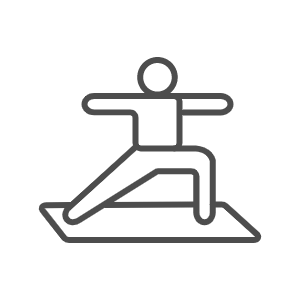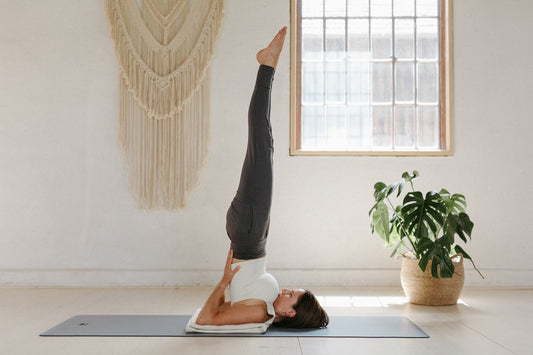
NEW In!
PURE-Matte Light TaupeShopping cart
Your shopping basket is empty
Yoga

Meditation
Sets & Bundles

We live in abundance. Everything is available at all times and is therefore taken for granted. In a world that works on the faster-higher-further principle, we tend to focus on what we lack. Instead of being thankful for what we already have.
When we wake up in the morning, there are countless reasons to be thankful: for the cozy bed we lie in, for the rays of sunshine peeking through the window, or for our healthy body, which lets us experience this new day.
But let's be honest: Most of the time, we're more concerned with getting annoyed that the alarm clock rings too early, that a hard day's work lies ahead of us, or that it's raining outside.
There is no question that it is not always easy to master the challenges of everyday life. We can plan to wake up with a smile on our faces, maybe start the day relaxed with a meditation and a few sun salutations, but it will not always work out.
The secret lies in making gratitude a fundamental attitude in life. Because our inner happiness is by no means dependent on external circumstances. It is up to us how we want to see things:
We can complain and whine about how stressful the day was. Or be thankful that the body is telling us that we have taken on too much and we urgently need a break.
We can get angry after a fight with our best friend. But we can also be thankful that this argument held up a mirror to us and practice forgiveness.
We can complain that the long-awaited vacation is canceled this year. But we can also be grateful for a beautiful home where we can feel safe and secure.
Even small, daily practiced gratitude rituals help to change our perspective and gradually draw attention to the many wonderful things in our lives.
A beautiful and beneficial ritual is to review the day before going to bed.
Write at least three things you are grateful for today in a notebook. Preprinted gratitude journals make this exercise even easier. In this way you learn to automatically direct your attention to everything positive - regardless of whether it is about certain events, your fellow human beings or material things.

Ho'oponopono is the name of this ritual, which has its origins in Hawaii. It is about dissolving anger and hurt, forgiving yourself and others and thus creating new space for gratitude and self-love.
Visualize the problem, situation, or person you are angry with. Then say the following four sentences in a row several times aloud, quietly or in your mind:
You can also use this exercise when you want to make peace with yourself or resolve an injury. The Hawaiian ritual is based on the idea that conflicts are resolved by consciously recognizing them and taking full responsibility for them. The last sentence expresses gratitude that we have now forgiven ourselves and others and are thus relieved of the burden.
Lie on your back for this exercise. Similar to Shavasana, the final relaxation pose at the end of every yoga practice, you lay your legs and arms relaxed on the mat. Feel free to put a blanket under your head or behind your knees so you can lie comfortably for a few minutes. Also make sure that you are dressed warm enough and do not freeze.
Close your eyes and thank all body parts and organs one after the other: “Thank you, dear legs, that I can go through life with you. Thank you dear eyes that I can see the beautiful colors and shapes. Thank you, dear heart, that you beat to the rhythm..."
Let your imagination run wild when formulating the sentences. End the exercise by thanking your whole body, your strength and energy, as well as all thoughts, sensations and perceptions.
The Sanskrit word "Dhanya Vad" means "thank you". As a mantra repeated aloud, silently or mentally, it supports a contented and benevolent attitude to life.
Use this mantra in your meditation practice to bring attention to the abundance, the possibilities, and any moments of joy in your life that you are grateful for.
Of course, it is unrealistic to believe that with the help of daily gratitude rituals we only walk through the world with rose-colored glasses. Life also has stumbling blocks in store for us, which sometimes make us angry or impatient, sad or despondent. However, if we allow ourselves to give space to these feelings as well, the energy keeps flowing and we can simply try to do better next time.
Why should we bring more gratitude into the small moments of everyday life? Because at the same time a more positive and joyful attitude towards life can mature, which then bears its fruit when we are once again exposed to a stressful, unpleasant or difficult situation.
Grateful people are also happy people because they are willing to focus on the many good things. Also, when you are thankful, you cannot be afraid, angry, or worried at the same time. Our brain is not able to devote itself to all sensations at the same time.
So it pays to give priority to gratitude!
Have fun trying!

Christmas is just around the corner and with it the questions: What am I giving away this year? And what do I wish for? How about more mindfulne...
Continue reading
Some of you probably know the Shoulderstand (Sarvangasana) from childhood: The “candle” was one of the exercises that I liked best in elementar...
Continue reading